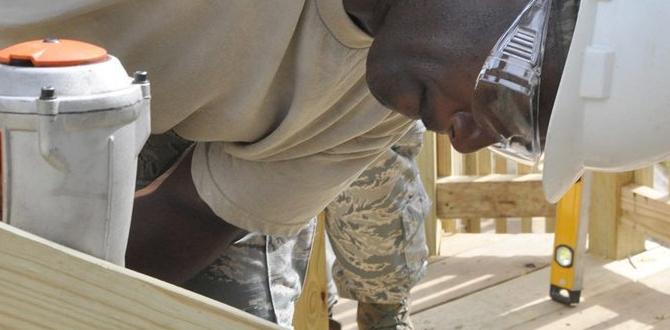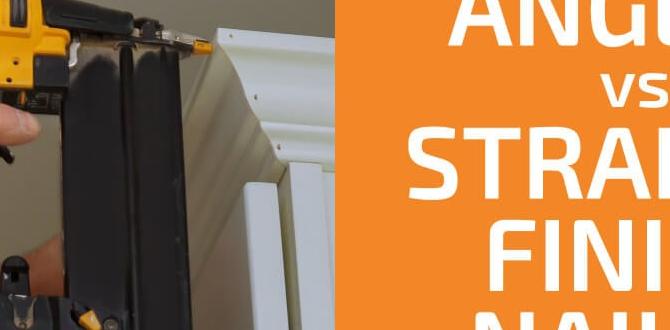Quick Summary
Choosing between gas and electric nailers boils down to your project needs. Gas nailers offer portability and power for tough jobs, while electric models provide convenience and consistency for lighter tasks. This guide breaks down their distinct features to help you pick the perfect one.
Hey there, DIY friends! Jack Shaffer here, Nailerguy, ready to tackle a question that trips up a lot of folks just starting out. You’re looking at nailers, dreaming of building that deck or framing that awesome new shelf, but you hit a wall. What’s the real difference between a gas nailer and an electric nailer? It can seem confusing with all the jargon and options out there. Don’t worry, we’ve all been there! This guide is your friendly walkthrough to understanding exactly what sets them apart. We’ll break down the power, the portability, and the practicalities so you can make a smart choice for your projects. Stick around, and by the end, you’ll feel confident choosing the right tool for the job!
Table of Contents
Understanding the Core Difference: Power Source & How They Work
At its heart, the difference between gas and electric nailers comes down to how they generate the force to drive a nail. It’s like comparing a powerful sports car to a reliable city sedan – both get you where you need to go, but they do it differently and excel in different situations.
Gas Nailers: The Portable Powerhouses
Gas nailers, often called cordless pneumatic or fuel-powered nailers, use a combination of a small fuel cell (like a tiny propane or butane canister) and a rechargeable battery. Here’s the magic:
- The “Ignition”: When you pull the trigger, a small amount of fuel is injected into a combustion chamber.
- The Spark: A spark from the battery ignites this fuel.
- The Push: This tiny explosion creates pressure that drives a piston, which then pushes the nail into your material.
- The Exhaust: A brief puff of exhaust gas is released, and the tool resets for the next nail.
This process means you don’t need an air compressor or a power cord. You just load nails, insert a fuel cell, pop in a charged battery, and you’re good to go! This freedom makes them incredibly popular for job sites, framing, roofing, and any situation where you need to move around a lot.
Electric Nailers: The Convenient and Consistent Workers
Electric nailers, on the other hand, rely on electricity to do the work. There are a couple of main types:
1. Corded Electric Nailers
These are the simplest. They plug directly into a wall outlet or a generator. Inside the tool, an electric motor powers a mechanism (often a spring-loaded or crankshaft system) that drives the nail. They are generally lighter and less expensive than their cordless counterparts.
2. Cordless Electric (Battery-Powered) Nailers
These are the more modern electric option. They use powerful rechargeable lithium-ion batteries, similar to those found in cordless drills. The battery powers a motor that compresses a spring or drives a mechanism to fire the nail. They offer the convenience of cordless operation without the need for fuel cells.
The key here is that electric nailers use a direct electrical source (either corded or battery) to create the force, rather than a combustion process.
Pros and Cons: When to Choose Which
Every tool has its strengths and weaknesses. Knowing these will help you match the nailer to your specific needs and budget. Let’s break it down:
Gas Nailer: The Good and the Not-So-Good
- Pros:
- Unmatched Portability: No cords, no air hoses. Freedom to roam!
- High Power: Excellent for driving large nails into tough materials like hardwood or concrete (with specific models).
- Fast Firing Speed: Can often fire nails quickly, making them great for production work like framing.
- Works in Various Temperatures: Generally less affected by cold than battery-powered tools.
- Cons:
- Fuel Cell Cost: You’ll need to continuously purchase fuel cells, adding an ongoing expense.
- Exhaust Fumes: They produce fumes, which can be noticeable in enclosed spaces. Ventilation is a must.
- Maintenance: Require more cleaning and maintenance due to the combustion engine.
- Battery Dependency: Still need charged batteries to operate the ignition and fan.
- Noise: Can be louder than electric models.
Electric Nailer: The Good and the Not-So-Good
Let’s look at both corded and cordless electrics here, as their pros/cons can overlap but also diverge.
- Pros:
- Lower Operating Cost: No proprietary fuel cells to buy. Just electricity!
- No Fumes: Ideal for indoor work or in confined spaces.
- Less Maintenance: Generally simpler mechanisms mean less upkeep.
- Consistent Power (especially corded): You get steady power as long as you have electricity.
- Quieter Operation: Typically run more quietly than gas nailers.
- Cons:
- Limited by Cord (for corded models): The length of your extension cord dictates your range.
- Battery Life/Weight (for cordless models): Batteries add weight and have limited runtimes before needing a recharge.
- Potentially Less Power (compared to gas): Some entry-level electrics might struggle with very dense hardwoods or large framing nails.
- Can be Bulky: Batteries and motor housings can make some models larger.
Key Differences at a Glance: A Comparison Table
To help you visualize the distinctions, here’s a table comparing the features side-by-side. This is a great way to quickly see which type might best suit your next project.
| Feature | Gas Nailer | Electric Nailer (Corded) | Electric Nailer (Cordless) |
|---|---|---|---|
| Power Source | Fuel Cell + Battery | AC Power Outlet | Rechargeable Battery |
| Portability | Excellent (No Cords/Hoses) | Limited by Cord Length | Very Good (Battery Dependent) |
| Power Output | Generally High, Good for Tough Materials | Consistent, Varies by Model | Good to High, Varies by Model & Battery |
| Operating Cost | Ongoing Fuel Cell Purchases | Lowest (if power is available) | Battery Replacement Over Time |
| Maintenance | Higher (Engine Cleaning, Spark Plugs) | Lowest | Low (Battery Care) |
| Fumes | Yes (Requires Ventilation) | No | No |
| Best For | Framing, Roofing, On-site work, Frequent moving | Workshop, Trim work, Small jobs, Stationary projects | Trim, Decking, DIY projects, Versatile indoor/outdoor use |
| Typical Project Types | House framing, Deck building, Roofing | Baseboards, Crown molding, Small repairs, Built-ins | Cabinet installation, Deck railing, Furniture building, Trim |
What Kind of Projects Are They Best For?
The “best” nailer isn’t about one being superior overall, but about which one is superior for a specific job. Let’s match them to typical DIY tasks.
Gas Nailers: For the Heavy-Duty and Mobile Pro
If you’re tackling large-scale projects where you’ll be moving around a lot, a gas nailer often shines. Think about:
- Framing Walls: Driving lots of nails quickly into dimensional lumber.
- Roofing: You’re high up, exposed, and need to move without dragging hoses.
- Deck Building: Especially if you’re working far from a power source or need to move along the deck surface.
- Demolition: Though not their primary use, their power can be useful.
The freedom from an air compressor is a massive advantage on big job sites. You can literally grab your nailer and go!
Electric Nailers: For the Versatile DIYer and Indoor Enthusiast
Electric nailers, particularly the cordless battery-powered ones, have become incredibly versatile and user-friendly for a wide range of DIY projects.
Corded Electric Nailers: The Workshop Staple
These are fantastic for projects where mobility isn’t a concern. If you have a dedicated workshop or are working on a single piece of furniture:
- Trim Installation: Perfect for baseboards, crown molding, and window/door casings. Their lighter weight and lack of fumes are ideal for interior finishing.
- Small Repairs: Quick fixes around the house.
- Cabinetry: Joining cabinet boxes or attaching face frames.
Plus, they’re often the most affordable option upfront.
Cordless Electric Nailers: The All-Rounder
These have truly revolutionized DIY. They offer a great balance of convenience and capability:
- Interior Finishing: Like their corded cousins, baseboards, molding, and trim work are a breeze.
- Furniture Making: Assembling smaller projects and furniture pieces.
- Cabinet Installation: Positioning and securing cabinets in place.
- Deck Railings & Accessories: Where precise placement and moderate power are needed.
- General Home Improvement: Anything from hanging shelves to building small garden structures.
The technology in these is constantly improving, offering more power and better battery life than ever before. For many DIYers, a good cordless electric nailer can handle 80-90% of their typical projects.
Choosing the Right Nailer for Common DIY Projects
Let’s get specific. You’re planning a project, but which nailer is your wingman?
Project: Building a Bookshelf
Recommendation: Cordless Electric Nailer (Brad or Finish Nailer)
Why: You’ll be working indoors, likely in a home environment. You need precision and a clean finish. A cordless electric nailer is perfect because it’s lightweight, fume-free, and can handle the smaller nails (like finish or brad nails) used for furniture and cabinetry. No need for a bulky compressor or noisy gas engine here.
Project: Installing New Baseboards
Recommendation: Cordless Electric Nailer (Finish Nailer) or Corded Electric Nailer
Why: Similar to the bookshelf, precision and a clean look are key. You’ll be working inside. A finish nailer (which uses thinner, headless nails for minimal visible holes) is ideal. A cordless electric offers mobility along the walls, while a corded electric is a great, cost-effective option if you have power access readily available in each room.
Project: Building a Wooden Deck Frame
Recommendation: Gas Nailer (Framing Nailer)
Why: This is where gas nailers often take the lead. You’ll be driving many large nails into dimensional lumber. A framing nailer (gas or high-power cordless electric) is designed for this. If you’re working on-site, away from power outlets, or need to move around the structure frequently, a gas framing nailer is exceptionally convenient. Be ready for the power and speed!
Project: Putting Up a Fence or Garden Gate
Recommendation: Gas Nailer (Framing or Multi-purpose Nailer) or High-Power Cordless Electric Nailer
Why: Depending on the size and type of wood, you’ll need good driving power. A framing nailer is excellent for sturdier fences. If it’s lighter duty, a multi-purpose nailer (often gas-powered) can work. If you have a powerful cordless system already, a high-voltage cordless electric nailer might also do the trick, offering more portability than a corded option.
Safety First! Essential Precautions
No matter which type of nailer you choose, safety is paramount. These are powerful tools, and a moment of inattention can lead to serious injury. Think of me, Jack Shaffer, telling you this – I’ve seen what can happen when safety takes a backseat. Always follow these guidelines:
General Safety Tips for All Nailers
- Always Wear Safety Glasses: Eye protection is non-negotiable. Always wear safety glasses or goggles that meet ANSI Z87.1 standards.
- Read the Manual: Seriously, read it. Every nailer is different. Know your tool inside and out.
- Never Point the Nailer at Yourself or Others: Treat it like a loaded firearm. A nail can penetrate skin and cause deep wounds.
- Keep Fingers Away From the Trigger Unless Firing: Don’t rest your finger on the trigger while handling or moving the tool.
- Ensure Proper Grip: Hold the nailer firmly with a secure grip.
- Be Aware of Recoil: Nailers, especially powerful ones, have recoil. Account for this, especially when firing rapidly.
- Work Area Safety: Ensure your work area is clear of debris, well-lit, and stable.
Specific Safety for Gas Nailers
- Ventilation: Always use in a well-ventilated area. Fumes can be harmful.
- Fuel Cell Handling: Store fuel cells properly and ensure they are correctly seated in the tool. Never puncture or force them.
- Hot Components: The exhaust ports and other parts can get hot during operation. Avoid touching them.
- Battery Safety: Use only the manufacturer-recommended batteries and ensure they are charged correctly.
Specific Safety for Electric Nailers
- Cord Safety (Corded): Inspect cords for damage before use. Avoid running cords through high-traffic areas where they can be a tripping hazard or get damaged. Use appropriate gauge extension cords. For more on safe electrical practices, you can check out resources from organizations like the Occupational Safety and Health Administration (OSHA).
- Battery Safety (Cordless): Handle batteries with care. Avoid exposing them to extreme temperatures. Use the correct charger for your batteries.
- Tool Stability: Ensure the tool is stable when you plug it in or attach a battery, so it doesn’t accidentally fire.
Maintenance: Keeping Your Nailer Running Smoothly
A little bit of care goes a long way in extending the life of your nailer and ensuring it performs reliably. Neglecting maintenance is a sure way to end up frustrated mid-project.
Gas Nailer Maintenance
- Regular Cleaning: The combustion chamber and exhaust ports can get carbon buildup. Clean them according to the manufacturer’s instructions, usually after a certain number of nails fired or a specific time interval.
- Lubrication: Some models require periodic lubrication of internal parts.
- Spark Plug: Check and clean or replace the spark plug as recommended.
- Battery Care: Keep batteries clean and store them properly.
- Fuel Cell Check: Ensure the fuel cell is properly seated and not leaking.
Electric Nailer Maintenance
- Keep Clean: Wipe down the exterior of the tool. Ensure the magazine (where the nails go) is free of debris.
- Lubrication: Some electric nailers require O-ring lubrication. Consult your manual.
- Battery Care (Cordless): Like gas nailers, keep batteries clean, store them at room temperature, and avoid full discharges if possible.
- Cord Inspection (Corded): Regularly check the power cord for nicks, cuts, or frays.
Always disconnect the power source (unplug or remove the battery) before performing any maintenance!
FAQ: Your Burning Questions, Answered!
Here are some common questions I hear from DIYers. Hopefully, these quick answers help clear things up!
Q: Can I use a gas nailer indoors?
A: Yes, but only in well-ventilated areas. Gas nailers produce exhaust fumes, similar to a small engine, which can build up indoors and are not good to breathe. Always ensure good airflow.
Q: Which type of nailer is best for trim work?
A: For trim work (like baseboards and crown molding), a finish nailer or brad nailer is ideal. These are typically electric (corded or cordless) because they offer precision, a clean finish with minimal nail holes, and don’t


